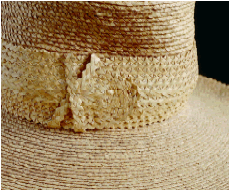Case study two - step 2:
Research the history and provenance of an object
This includes photos of it in use, notes about the owner or place where it was used, when it was made or purchased, and general history.

Cabbage tree hat example:
Notes associated with the hat record that it was made by Mrs Lionel Hurry, nee Sarah Denniss, for her nephew Albert Denniss, son of her brother George, when he was a small boy holidaying with her at Vine Cottage, Flinders Street, Albion Park. It was probably made in the late 19th or early 20th century.
Cabbage tree hats were characteristic of male dress in the Australia bush in the 19th century. First recorded in 1799, they were worn by convicts, shepherds, poets, explorers and the well-to-do. They are described in the works of writers such as Henry Lawson and Mary Gilmore, and seen in many paintings and photographs of daily life on the goldfields and in the bush. Later in the century, the larrikins of Sydney’s Rocks area were also distinguished by their cabbage tree hats and dubbed the ‘Cabbage Tree Mob’.
Straw plaiting was a rural craft in Britain. It was taught to convicts awaiting transportation, and was a prison craft in Australia in the 19th century. Shepherds in the bush, who were often freed convicts, also carried out straw plaiting. It was suited to occupations and circumstances where there was plenty of time and limited resources. By the second half of the 19th century the hats were made by men and women in many circumstances—from factory workers in Sydney and regional towns, to housewives and rural workers supplementing farm incomes—and sold to drovers and other travellers along the main roads of New South Wales. Plaits were also sold separately to be made into hats later. Very fine cabbage tree hats were also exhibited in many international exhibitions. These hats are significant as the only distinctive item of Australian dress entirely made from Australian materials.